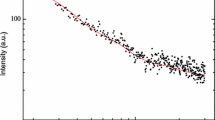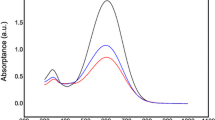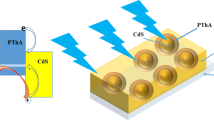Abstract
Hexamolybdate is a Lindqvist polyoxometalate cluster. Conjugated polymer is covalently bonded with hexamolybdate cluster via side chain. The conjugated polymer containing metal cluster as side-chain pendant has already been investigated for synthesis and optical properties. Herein, the TDDFT calculation were used to investigate the second-order nonlinear optical (NLO) response of a crystal system. A robust wide range of charge-transfer has been observed via donor (metal cluster) towards the acceptor (end organic ring), consequently responsible for the large NLO response of the studied system. This type of charge transfer containing material is considered to be an efficient candidate for NLO applications. However, polymer shows not only efficient charge transfer but also better charge transporting characteristics. The answer whether cluster is donor or acceptor has been explained through DFT calculations.
Graphical Abstract
Interestingly, at a specific chain length, the organic ligand (ring) acts as an acceptor while metal cluster behaves like a donor: Clarification by DFT calculations through nonlinear electro-optic modulation.








Similar content being viewed by others
References
G. A. Lindsay and K. D. Singer (eds.), Polymers for Second-Order Nonlinear Optics; ACS Symposium Series 601 (American Chemical Society, Washington, DC, 1995).
(a) D. S. Chemla and J. Zyss (eds.), Nonlinear Optical Properties of Organic Molecules and Crystals (Academic Press, New York, 1987). (b) S. R. Marder, J. E. Sohn, and G. D. Stucky (eds.), Materials for Nonlinear Optics: Chemical Perspectives. ACS Symposium Series (American Chemical Society, Washington, DC, 1991). (c) Optical Nonlinearities in Chemistry. Chem. Rev. 1994, 94(1). (c) S. Miyata, and H. Sasabe, Poled Polymers and Their Applications to SHG and EO Devices (Gordon & Breach, Amsterdam, 1997). (d) H. S. Nalwa, Nonlinear Optics of Organic Molecules and Polymers (CRC Press, Boca Raton, 1997, 254).
(a) T. J. Marks and M. A. Ratner (1995), Design, Synthesis, and Properties of Molecule-Based Assemblies with Large Second-Order Optical Nonlinearities. Angew. Chem. Int. Ed. Engl., 34, 155–173. (b) R. G. Denning (1995), Chromophores for second-order non-linear optic materials. J. Mater. Chem. 5, 365–378. (c) S. R. Marder, B. Kippelen, A. K.-Y. Jen, and N. Peyghambarian (1997), Design and synthesis of chromophores and polymers for electro-optic and photorefractive applications. Nature 388, 845–851.
(a) U. Keshari, S. P. Korna, and N. P. Prasad (1993), Reversal of excitation behavior of proton-transfer vs. charge-transfer by dielectric perturbation of electronic manifolds. J. Phys. Chem. 97, 3525–3529. (b) J. O. Morley, M. G. Hutchings, J. Zyss, and I. Ledoux (1997), Non-linear optical activity of azo dyes. Conformational effects on the quadratic hyperpolarisability of an azothiophene dye. J. Chem. Soc. Perkin Trans. 2, 1139–1142.
T. J. J. Muller, J. P. Robert, E. Schmalzlin, C. Brauchle, and K. Meerholz (2000). A straightforward modular approach to NLO-active β-amino vinyl nitrothiophenes. Org, Lett. 2, 2419–2422.
(a) S.-S. P. Chou, D. J. Sun, H.-C. Lin, and P.-K. Yang (1996), Second-order nonlinearities and crystal structures of methylsulfonyl- and phenylsulfonyl-substitoted thiophene imino dyes. Chem. Commun. 1045–1046. (b) S.-S. Chou, G.-T. Hsu, and H.-C. Lin (1999). Tetrahedron Lett. 40, 2157–2160.
H. E. Katz, K. D. Singer, J. E. Sohn, C. W. Dirk, L. A. King, and H. M. Gordon (1987). Greatly enhanced second-order nonlinear optical susceptibilities in donor-acceptor organic molecules. J. Am. Chem. Soc. 109, 6561–6563.
B. R. Cho, N. K. Son, S. J. Lee, T. I. Kang, M. S. Han, S. J. Jeon, N. W. Song, and D. Kim (1998). First order hyperpolarizabilities of 2-[2-(p-diethylaminophenyl)vinyl]- furan derivatives. Tetrahedron Lett. 39, 3167–3170.
K. Belfield, C. Chinna, and K. Schafer (1997). Synthesis of donor–acceptor stilbenes bearing phosphonate ester electron-withdrawing groups. Tetrahedron Lett. 38, 6131.
S. Sun, C. Zhang, L. Dalton, S. Garner, A. Chen, and W. Steier (1996). 1,3-Bis(dicyanomethylidene)indane-based second-order NLO materials. Chem. Mater. 8, 2539–2541.
M. Ahlheim, M. Barzoukas, P. Bedworth, M. Blanchard-Desce, A. Fort, Z. Hu, S. Marder, J. Perry, C. Runser, M. Staehelin, and B. Zysset (1996). Chromophores with strong heterocyclic acceptors: a poled polymer with a large electro-optic coefficient. Science 271, 335–337.
T. Coradin, K. Nakatani, I. Ledoux, J. Zyss, and R. Clement (1997). Second harmonic generation of dye aggregates in bentonite clay. J. Mater. Chem. 7, 853–854.
S. H. Kang, Y.-M. Jeon, K. Kim, S. Houbrechts, E. Hendrickx, and A. Persoons (1995). The diazonium group: an electron acceptor for large molecular hyperpolarizabilities. J. Chem. Soc. Chem. Commun. 635–636.
C.-F. Shu, W. J. Tsai, J.-Y. Chen, A. K.-Y. Jen, Y. Zhang, T.-A. Chen (1996). Synthesis of second-order nonlinear optical chromophores with enhanced thermal stability and nonlinearity: a conformation-locked trans-polyene approach. Chem. Commun. 2279–2280.
F.-Y. Li, J. Zheng, L.-P. Jin, X.-S. Zhao, T.-T. Liu, and J.-Q. Guo (2000). Photoelectric conversion and second-order optical nonlinearity of Langmuir-Blodgett films of a novel dipolar two-dimensional material. J. Mater. Chem. 10, 1287–1290.
S. Barlow, H. E. Bunting, C. Ringham, J. C. Green, G. U. Bublitz, S. G. Boxer, J. W. Perry, and S. R. Marder (1999). Studies of the electronic structure of metallocene-based second-order nonlinear optical dyes. J. Am. Chem. Soc. 121, 3715–3723.
(a) G. Iftime, P. G. Lacroix, K. Nakatani, and A. C. Razus (1998). Push-pull azulene-based chromophores with nonlinear optical properties. Tetrahedron Lett. 39, 6853–6856. (b) P. G. Lacroix, I. Malfant, G. Iftime, A. C. Razus, K. Nakatani, and J. A. Delaire (2000). Azo-azulene derivatives as second-order nonlinear optical chromophores. Chem. Eur. J. 6, 2599–2608.
a) N. Ma, L. K. Yan, W. Guan, Y. Qiu, and Z. M. Su (2012). Theoretical investigation on electronic structure and second-order nonlinear optical properties of novel hexamolybdate-organoimido-(car)borane hybrid. Phys. Chem. Chem. Phys. 14, 5605–5612. b) H. Q. Wang, L. Wang, R. R. Li, J. T. Ye, Z. Z. Chen, H. Chen, Y. Q. Qiu, and H.-M. Xie (2016). Second-order nonlinear optical properties of carboranylated square-planar Pt(II) zwitterionic complexes: one-/two-dimensional difference and substituent effect. J. Phys. Chem. A, 120(46), 9330–9340.
a) G. Berkovic and Y. R. Shen (1987). The effect of conjugation length and electron donor groups on the second order nonlinear polarizability of cyano substituted aromatic molecules. Mol. Cryst. Liq. Cryst. 150, 607–616. b) A. Dulcic, C. Flytzanis, C. L. Tang, D. Pépin, M. Fétizon, and Y. Hoppilliard (1987). Length dependence of the second-order optical nonlinearity in conjugated hydrocarbons. J. Chem. Phys. 74, 1559–1563.
J. Zyss and I. Ledoux (1994). Nonlinear optics in multipolar media: theory and experiments. Chem. Rev. 94, 77–112.
F. Meyers, S. R. Marder, B. M. Pierce, and J. L. Bredas (1994). Electric field modulated nonlinear optical properties of donor-acceptor polyenes: sum-over-states investigation of the relationship between molecular polarizabilities (.alpha.,beta., and.gamma.) and bond length alternation. J. Am. Chem. Soc. 116, 10703–10714.
E. M. Breitung, C. F. Shu, and R. J. McMahon (2000). Thiazole and thiophene analogues of donor–acceptor stilbenes: molecular hyperpolarizabilities and structure–property relationships. J. Am. Chem. Soc. 122, 1154–1160.
P. R. Varanasi, A. K. Y. Jen, J. Chandrasekhar, I. N. N. Namboothiri, and A. Rathna (1996). Efficient second-order nonlinear optical molecules: theoretical investigation on push–pull heteroaromatic stilbenes. J. Am. Chem. Soc. 118, 12443–12448.
U. D. L. Albert, T. J. Marks, and M. A. Ratner (1997). Large molecular hyperpolarizabilities. Quantitative analysis of aromaticity and auxiliary donor–acceptor effects. J. Am. Chem. Soc. 119, 6575–6582.
H. Kang, A. Facchetti, H. Jiang, E. Cariati, S. Righetto, R. Ugo, C. Zuccaccia, A. Macchioni, C. L. Stern, Z. Liu, S. T. Ho, E. C. Brown, M. A. Ratner, and T. J. Marks (2007). Ultralarge hyperpolarizability twisted π-electron system electro-optic chromophores: synthesis, solid-state and solution-phase structural characteristics, electronic structures, linear and nonlinear optical properties, and computational studies. J. Am. Chem. Soc. 129, 3267–3286.
H. Kang, A. Facchetti, P. Zhu, H. Jiang, Y. Yang, E. Cariati, S. Righetto, R. Ugo, C. Zuccaccia, A. Macchioni, C. L. Stern, Z. Liu, S. T. Ho, and T. J. Marks (2005). Exceptional molecular hyperpolarizabilities in twisted p-electron system chromophores. Angew. Chem. Int. Ed. 44, 7922–7925.
J. S. Yang, K. L. Liau, C. Y. Li, and M. Y. Chen (2007). Meta conjugation effect on the torsional motion of aminostilbenes in the photoinduced intramolecular charge-transfer state. J. Am. Chem. Soc. 129, 13183–13192.
(a) G. te Velde, F. M. Bickelhaupt, E. J. Baerends, C. Fonseca Guerra, S. J. A. van Gisbergen, J. G. Snijders, and T. Ziegler (2001). Chemistry with ADF. J. Comput. Chem. 22, 931–967. (b) C. Fonseca Guerra, J. G. Snijders, G. Te Velde, and E. J. Baerends (1998). Theor. Chem. Acc. 99, 391–403. (c) ADF2006.01, SCM, Theoretical Chemistry, Vrije Universiteit, Amsterdam, The Netherlands. http://www.scm.com.
E. van Lenthe, E. J. Baerends, and J. G. Snijders (1993). Relativistic regular two-component hamiltonians. J. Chem. Phys. 99, 4597–4610.
A. D. Becke (1988). Density-functional exchange-energy approximation with correct asymptotic behavior. Phys. Rev. A 38, 3098–3100.
J. P. Perdew (1986). Density-functional approximation for the correlation-energy of the inhomogenous electron gas. Phys. Rev. B 33, 8822–8824.
S. J. A. van Gisbergen, J. G. Snijders, and E. J. Baerends (1999). Excitation energies and oscillator strengths. Comput. Phys. Commun. 118, 119–138.
R. van Leeuwen and E. J. Baerends (1994). Exchange-correlation potential with correct asymptotic behaviour. Phys. Rev. A 49, 2421–2431.
(a) S. J. A. van Gisbergen, V. P. Osinga, O. V. Gritsenko, R. van Leeuwen, J. G. Snijders, and E. J. Baerends (1996). Improved density functional theory results for frequency dependent polarizabilities, by the use of an exchange correlation potential with correct asymptotic behaviour. J. Chem. Phys. 105(7), 3142–3151. (b) S. J. A. van Gisbergen, J. G. Snijders, and E. J. Baerends (1998). Calculating frequency dependent hyperpolarizabilities with density functional theory. J. Chem. Phys. 109(24), 10644.
S. J. A. van Gisbergen, J. G. Snijders, and E. J. Baerends (1997). Time-dependent density functional results for the dynamic hyperpolarizability of C60. J. Chem. Phys. Rev. Lett. 78, 3097–3100.
S. J. A. van Gisbergen, J. G. Snijders, and E. J. Baerends (1998). Calculating frequency dependent hyperpolarizabilities with density functional theory. J. Chem. Phys. 109, 10644–10657.
a) M. R. S. A. Janjua, C. G. Liu, W. Guan, J. Zhuang, S. Muhammad, L. K. Yan, and Z. M. Su (2009). Prediction of remarkably large second-order nonlinear optical properties of organoimido-substituted hexamolybdates. J. Phys. Chem. A 113, 3576–3587. b) M. R. S. A. Janjua, W. Guan, L. K. Yan, Z. M. Su, A. Karim, and J. Akbar (2010). Quantum chemical design for enhanced second-order NLO response of terpyridine-substituted hexamolybdates. Eur. J. Inorg. Chem. 3466–3472.
a) W. Guan, G. C. Yang, L. K. Yan, Z. M. Su (2006). Prediction of second-order optical nonlinearity of trisorganotin-substituted β-Keggin polyoxotungstate. Inorg. Chem. 45, 7864–7868. b) M. R. S. A. Janjua (2017). Nonlinear optical response of a series of small molecules: quantum modification of π-spacer and acceptor. J. Iran. Chem. Soc. doi:10.1007/s13738-017-1141-x. c) M. R. S. A. Janjua (2017). First-principle study on the effect of pi-spacers on small molecule acceptors: quantum design of organic solar cells and NLO compounds. J. Clust. Sci.. doi:10.1007/s10876-017-1233-x. d) M. R. S. A. Janjua (2017). First theoretical framework of di-substituted donor moieties of triphenylamine and carbazole for NLO properties: quantum paradigms of interactive molecular computation. Mol. Simul. doi:10.1080/08927022.2017.1332413.
L. K. Yan, M. S. Jin, J. Zhuang, C. G. Liu, Z. M. Su, and C. C. Sun (2008). Theoretical study on the considerable second-order nonlinear optical properties of naphthylimido substituted hexamolybdates. J. Phys. Chem. A 112, 9919–9923.
G. C. Yang, W. Guan, L. K. Yan, Z. M. Su, L. Xu, and E. B. Wang (2006). Theoretical study on the electronic spectrum and the origin of remarkably large third-order nonlinear optical properties of organoimide derivatives of hexamolybdates. J. Phys. Chem. B 110, 23092–23098.
J. Zhuang, L. K. Yan, C. G. Liu, Z. M. A Su (2009). Quantum chemical study of the structure, bonding characteristics and nonlinear optical properties of aryloxido and salicylaldehydo derivatives of [XW5O18]3–(X = Zr or Ti). Eur. J. Inorg. Chem. 2529–2535.
W. Guan, G. C. Yang, L. K. Yan, and Z. M. Su (2006). How do the different defect structures and element substitutions affect the nonlinear optical properties of lacunary Keggin polyoxometalates? A DFT study. Eur. J. Inorg. Chem. 20, 4179–4183.
D. M.-L. Carey, A. Munoz-Castro, C. J. Bustos, J. M. Manriquez, and R. Arratia-Perez (2007). π-donor/acceptor effect on lindqvist type polyoxomolibdates because of various multiple-bonded nitrogenous ligands. J. Phys. Chem. A 111, 6563–6567.
L. K. Yan, G. C. Yang, W. Guan, Z. M. Su, and R. S. Wang (2005). Density functional theory study on the first hyperpolarizabilities of organoimido derivatives of hexamolybdates. J. Phys. Chem. B 109, 22332–22336.
B. Xu, M. Lu, J. H. Kang, D. Wang, J. Brown, and Z. H. Peng (2005). Synthesis and optical properties of conjugated polymers containing polyoxometalate clusters as side-chain pendants. Chem. Mater. 17, 2841–2851.
(a) J. L. Oudar, D. S. Chemla (1977). Hyperpolarizabilities of the nitroanilines and their relations to the excited state dipole moment. J. Chem. Phys. 66, 2664–2668. (b) J. L. J. Oudar (1977). Optical nonlinearities of conjugated molecules. Stilbene derivatives and highly polar aromatic compounds. Chem. Phys. 67, 446–457.
Acknowledgements
The author would like to acknowledge the support provided by the Deanship of Scientific Research (DSR) at King Fahd University of Petroleum & Minerals (KFUPM) for funding this work through project No. SR161009.
Author information
Authors and Affiliations
Corresponding author
Electronic supplementary material
Below is the link to the electronic supplementary material.
Rights and permissions
About this article
Cite this article
Haroon, M., Mahmood, R. & Janjua, M.R.S.A. An Interesting Behavior and Nonlinear Optical (NLO) Response of Hexamolybdate Metal Cluster: Theoretical Insight into Electro-Optic Modulation of Hybrid Composites. J Clust Sci 28, 2693–2708 (2017). https://doi.org/10.1007/s10876-017-1255-4
Received:
Published:
Issue Date:
DOI: https://doi.org/10.1007/s10876-017-1255-4




